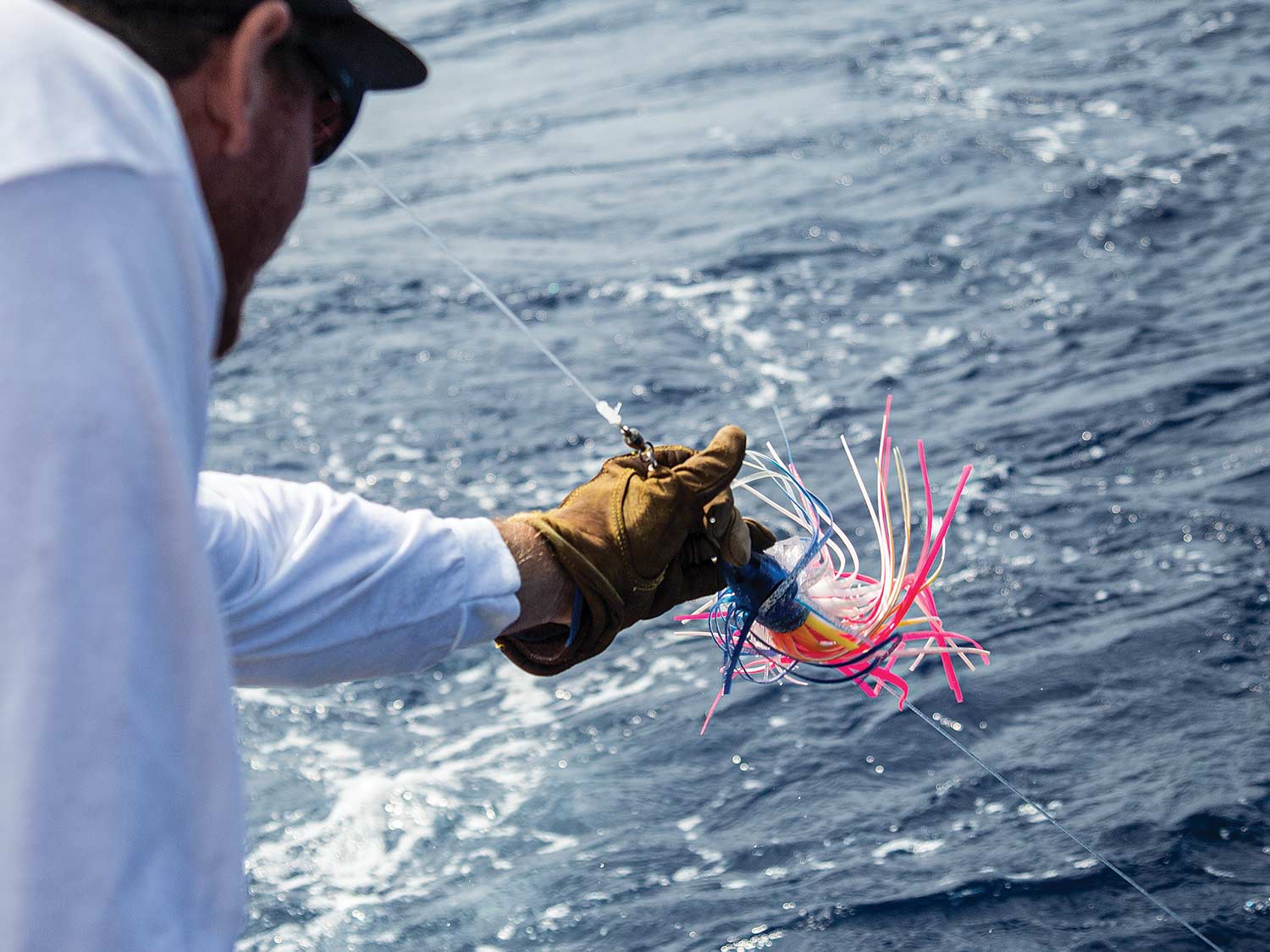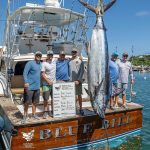Article Courtesy: marlinmag.com | Originally Published: 6/22/2021 | Click here for original article
A Lure Maker’s Odyssey
In our sport, no piece of gear is probably scrutinized, inquired about, second-guessed or glorified more than the lure. “What did you catch ‘em on?” and “What color?” might be two of the most frequently asked questions in the industry, from first-time charter guests to seasoned, professional skippers. But even with all the hours spent staring at shelves full of lures (and all the dollars we spend on them), the lure-maker—and the process in which these performance-driven pieces of art are created—is often taken for granted. The path to creating something a fisherman will trust to tantalize a giant blue marlin—should he be fortunate enough to cross paths with one—can be a rocky road. And similar to fighting that fish of a lifetime, the hours of pain and stress involved in lure-making are rewarding—if you can stick it out.
From Humble Beginnings
Nick Durham grew up in Sydney, Australia, but began his big-game-fishing obsession in Tonga, where his mom was working with AusAid during one of his school holidays. At about 15 years old, he hitched a ride on one of the local tuna hand-lining skiffs to get his first taste of bluewater fishing for offshore species and then caught his first billfish —a sailfish—around the same time. Once his family was back home in Sydney, Durham’s dad called in a favor with an old friend to introduce him to the Sydney Game Fishing Club in hopes of finding some crews to nurture his love of fishing. As luck would have it, Glenn and Karen Wright were one of the first people whom Durham met and offered for him to come out with them on their boat, at the time a 32-foot Cresta named Tantrum.
Fishing with the Wrights ended up being the perfect boot camp for Durham to learn the ins and outs of big-game fishing, with their program being focused mostly on billfish, tuna and sharks. They pulled lures often and targeted blue marlin more than most fishing teams in the area at that time. The Tantrum team also spent significant time fishing light tackle for blues, which in turn led to some of those expensive lures being lost. This important fact, as well as Durham being introduced to the Hawaiian-style trolling lures, is what really got him interested in making lures of his own.

Hawaiian-style trolling lures are one part art, one part black magic. Capt. Joe Byrum
“I still remember the first day I saw a Hawaiian-made tube lure running,” Durham recalls. “I was blown away by the rooster-tailing action and all the cool things that tubes do. I had no idea a lure could do that, and of course it soon got eaten by a blue marlin on the long corner.” He started a lure collection of his own and came across Jim Rizzuto’s Luremaking series of books as a how-to guide to start making them himself. As he began to try to craft his own creations, he’d also have the good fortune of a family friend with a hobby of clock-making. He taught Durham how to use a metal lathe and assisted him with turning his first lure: a tube made out of wood that would become the master for his first mold. Durham pays homage to the shape that inspired him with the tube shape that’s a part of his logo today. As the passion grew, the need for a workshop became apparent, so his dad offered the back garden shed, and together they dug a 20-yard trench from the house to facilitate a power supply. This spawned what would soon be the first home of Tantrum Lures.
Working at a local supermarket part time while finishing high school, Durham saved his money to buy a lathe of his own and began to experiment with making his own designs. During this period of figuring out the process with various successes and failures, he reached out to a few other lure-makers to get some insight, and found that many weren’t too keen on offering any help. But through an internet forum, he was able to strike up a friendship with legendary captain and lure-maker Bart Miller, who proved to be an invaluable resource. Durham and Miller began an email exchange, with Miller answering questions and offering advice to steer him in the right direction and solve some of the problems he was encountering along the way. Durham credits him with nurturing his growth as a lure-maker and helping to flatten the learning curve during a critical time.
As Durham achieved success in the shop, he also began to produce it on the water. His lures were finding their targets with blue marlin catches behind Tantrum. Around age 18, he had the opportunity to wire his first 500-pound blue marlin caught on his gear, the Large Bandit that’s still one of his most popular shapes.

Tantrum lures are designed to be reliable performers in the spread. Founder Nick Durham adjusts a lure’s hook-set before deployment. Capt. Joe Byrum
Blood, Sweat and Tears
Almost all success stories have their share of struggles in the beginning and growing phases, and Tantrum Lures was no exception. As Durham made more lures and word got out about his success locally, he began to get orders, selling his first lure at age 19. Since he didn’t get started with the intention of this becoming a full-fledged business, Durham says that he was often overwhelmed with trying to produce the quality of lures that he demanded at the pace required to fulfill the orders that were starting to flood in. He says that he probably woke up the neighbors a few nights when imperfect lures came out of the mold and were hurtled against the shed wall as penance. He found his footing but realized that he might have to make changes to get the consistency that he coveted from his products. This led him to switch up his process from the traditional polyester resin to a polyurethane resin that would enable each lure to come out of the mold as an almost-finished product. Not only would this move speed up production, but the lack of sanding and polishing would make each completed head design identical in shape and maximize the consistency of their performance as well.
But completely flipping the process of an already successful project is no easy task. Changing from polyester to polyurethane could be compared to a boatbuilder switching from cold-molded wood hulls to straight fiberglass. Durham freely admits that this stage of Tantrum was among his most difficult periods as a lure-maker, and that giving up on the change certainly entered his mind. Not only did the switch require a significant financial sacrifice in equipment, but the nuances of the Sydney climate also created its own set of problems. There was no one to ask for advice, so meeting his goal was simply a matter of trial and error—a lot of it.

From handcrafting the inserts to working on new head shapes and styles, each lure receives a personal touch. Capt. Joe Byrum
“There were all kinds of stuff-ups, weird frosting on the surface of the heads, or resin not properly curing —problems where you wonder if it’s really worth it,” Durham says about that time. “But then I came out the other side. Along the journey, there’s so much blood, sweat and tears that go into it, in the end, I guess it’s the setbacks and failures that really make you.”
With time, effort and a lot of lure heads that ended up in the trash, Durham got the process dialed in. It took about a year of successes and failures before he started to consistently get the product he was looking for. He found solutions to one problem at a time until each Bandit and Plunger came out just like the last, and the blemish pile shrank to the rare cosmetic imperfection. Now Tantrum could be more streamlined and efficient, as well as guarantee that if you happen to lose your magic Tantrum, it could be replaced with no loss in performance. Durham had finally made it to the other side, and Tantrum was starting to become more than just a part-time business.

Since each lure is hand-crafted, the options for custom colors or skirt combinations are nearly endless. Capt. Joe Byrum
The Modern Days
In 2017, Durham decided to leave his full-time job in marketing and put his full attention into Tantrum Lures. He thought his corporate hiatus might be just a yearlong trial run, but after a season of testing in Kona, Hawaii, while fishing with Jason Holtz on Pursuit, the switch was permanent. Fishing in the birthplace of modern lure-fishing and in the perfect proving grounds for his creations, his lures were an immediate success. Legendary Kona skipper Chip Van Mols was another mentor to Durham in the marlin fishing game, and his meticulous rigging style matched Durham’s detail-oriented approach. Van Mols offered his input on the Tantrum shapes, which Durham gladly took into account when tweaking and modifying his products. He credits Van Mols’ honest feedback as one of his biggest influences in making refinements and improvements to the Tantrum line; the experienced captain became an early Tantrum ambassador and adviser, as he remains today. Other Kona captains took notice as well, with Tantrums soon becoming a staple in one of the most hardcore lure fisheries in the world.
Falling in love with the climate and year-round blue marlin lure fishery, Durham and his wife, Alex, decided to make the full-time move to the Big Island of Hawaii in November 2019. He trained a friend back in Sydney to take over production of his lures in Australia, while he focused on his custom shop in Kona, simultaneously doing daily research and development while fishing on Pursuit. Alex’s involvement in Tantrum also can’t go unmentioned: She takes a large role with Tantrum in everything from business dealings to pouring lures when her husband is away fishing. She’s also no stranger to big fish; she once held the women’s 130-pound record Pacific blue marlin of 958 pounds, caught with Durham and Van Mols in 2013.

Durham credits the late Capt. Bart Miller for his help in getting started as a lure-maker. Capt. Joe Byrum
Durham takes pride in the fact that his lures are built for functionality on the water. He’s focused on making the Hawaiian-style lure more user-friendly to both novices and professionals to run with regularity. “Pulling these types of lures is known as an art form, and it’s often a bit of a lottery if your new lure is going to run the way you want,” he says. “I think what I’ve done is built a product that you can rely on to do what you want it to do right out of the gate.” His products are created for practical application, and they have the track record to back that up. It’s a brand that started because of demand and has continued due to the productivity of the products. Durham personally fishes his lures behind Pursuit out of Kona more than 200 days per year, as well as gathering input from his pro staff and top captains around the world running Tantrums. You can guarantee that almost every day a Tantrum is being pulled through the water somewhere.

Recently, Durham expanded his product line to include a trolling hook that he designed and is produced by Fudo. This is just another example of his seeing a need in the marlin trolling world and trying to improve on what’s currently available—a benefit of being a lure and tackle manufacturer who uses and relies on the success of his own products in the context of a professional crewman. These hooks have already made an impact on the marlin fishing world, with rave reviews from those who have been using them so far. He’s also created a line of Strobez skirts and will soon release a full line of rubber skirts to more completely meet the needs of trolling lure-fishermen. All of these products are based on real-world testing from some of the best big-game fishermen who want to maximize the quality of the gear they pull.

Durham continues research and development amid Hawaii’s calm seas and blue marlin as frequently as possible. Capt. Joe Byrum
Durham’s foray into lure-making has been a wild and winding road. Through hard work and perseverance, he’s become known as one of the best and most detail-oriented lure-makers in the game today. With his already successful line of lures and his new additions of skirts and trolling hooks, Tantrum hopes to guide anglers all over the world to bigger fish and more achievements in the coming years. This dedication to billfishing success is the reason that captains everywhere have confidence when they throw a Tantrum over the transom.






